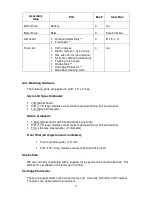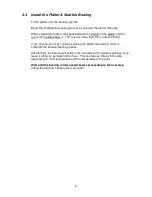
10
In these instructions, we refer to the “right” switch position as lighting the blue
LED and activating its adjacent trim pot.
We set the “blue” position to 33 and the “red” position to 45.
If you prefer, you may reverse these speed assignments.
General
Verify that the belt is tracking correctly on the pulley and platter. If it is
not, align it per the steps described in the previous sections.
Place the Anvil on the record spindle along with your strobe disk of
choice.
Plug the controller umbilical cord into the battery, turn the switch on the
motor pod to the right (the blue LED will light), and give the platter a
helping push-start.
Set the speed to 33 rpm as verified by your strobe disk
Method 1 -Setting belt tension by observing the platter speed:
Switch the motor off and stop the platter.
Carefully move the motor pod to slightly tension the belt.
Start the motor again and use your strobe disk to observe whether the platter
speeds up or slows down.
If the platter speeds up, repeat this process (turn off motor, stop platter,
increase tension) and restart the motor - observing whether the platter speed
has sped up or slowed down.
If the platter slows down, follow the above procedure, but reduce the belt
tension instead.
You will likely overshoot the "sweet spot" and have to return to it. It's not
critical to be exactly "spot on" with this setting, but rather to find the general
area where the platter spins the fastest
At this point, you should find that the belt tension is at a point where it is
barely tighter than the point at which it has observable flutter.
Don't loosen the tension to this flutter point, although we have observed good
speed stability with Mylar belts set so loose as to flutter slightly.
Method 2 - Setting belt tension by the “flutter” method:
This method works well with our supplied Mylar belts. It is not as predictable
when using VHS tape belts.
Using the method described above (adjusting the tension with the motor
switched off and the platter stopped), set the tension to just barely eliminate
belt flutter.
Method 3 - Setting belt tension by direct measurement:
After you’ve installed the belt once or twice, you will likely use this method.










































